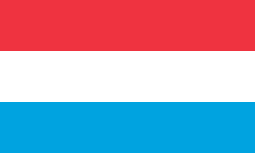This article needs additional citations for verification. (August 2021) |
 | |
| Rout, Wäiss, Himmelblo | |
| Use | National flag |
|---|---|
| Proportion | 3:5 |
| Adopted | 1848 (de facto) 1993 (de jure) |
| Design | A horizontal triband of red, white and light blue |
 | |
| Use | National flag |
| Proportion | 1:2 |
| Design | A horizontal triband of red, white and light blue, only in 1:2 ratio. |
 | |
| Use | Civil flag and ensign |
| Proportion | 1:2 or 3:5 (civil) and 5:7 (ensign) |
| Design | Ten alternating stripes of white and light blue, with a red lion taken from the coat of arms superimposed on the center. |

The national flag of Luxembourg[a] consists of three horizontal stripes, watermelon red, white and light blue, and can be in 1:2 or 3:5 ratio. It was first used between 1845 and 1848 and officially adopted in 1993. It is informally called in the country, «rout, wäiß, blo» ("red, white, blue").[1]
Luxembourg had no flag until 1830, when patriots were urged to display the national colours. The flag was defined as a horizontal tricolour of red, white, and blue in 1848, but it was not officially adopted until 1993. The tricolour flag of Luxembourg is graphically almost identical to the flag of the Netherlands, except that it is longer and its light blue stripe and red stripe are a lighter shade. The red, white, and light blue colours were derived from the coat of arms of the House of Luxembourg.
Cite error: There are <ref group=lower-alpha> tags or {{efn}} templates on this page, but the references will not show without a {{reflist|group=lower-alpha}} template or {{notelist}} template (see the help page).
- ^ L'essentiel (21 March 2019). "Le gouvernement ne touchera pas au drapeau". L'essentiel. Retrieved 2019-03-28.